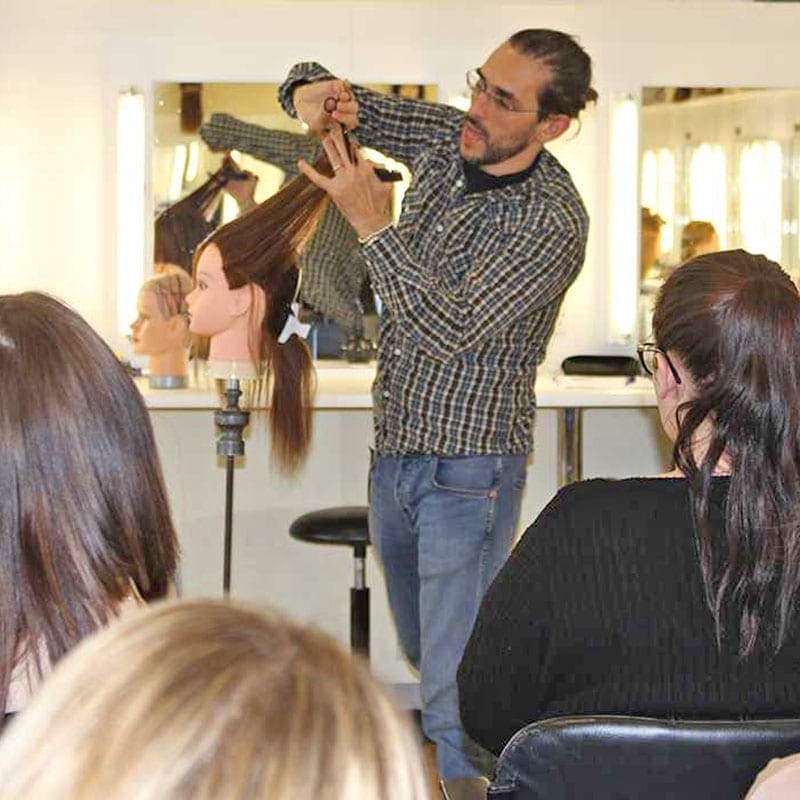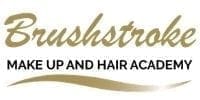Today’s make-up artist has to be really versatile, especially to work in film, TV, stage and fashion. It’s not just being able to switch into sfx and different looks and authentic period make-up. Make-up artists are expected to be skilled with hair too. And it makes sense – make-up and hair complement one another so being able to create a complete look is clearly the ideal. It’s also more cost effective for production teams to book one person to do both jobs. (See what Head of Make-Up for ITV’s Coronation Street, Elizabeth Armistead, says about the matter.)
This doesn’t mean specialists in make-up or hair aren’t needed because they are – particularly on big budget productions. But there’s no doubt that the ability to do both makes for one powerful skill-set.
Every single Brushstroke course teaches hair skills and, overall, we dedicate a lot of our syllabus to the subject. Two of our qualification courses (ITEC Hairdressing & Barbering and ITEC Barbering) are dedicated to hair. That’s how seriously we take the subject at Brushstroke.
“There’s always a need to do something with hair”
According to Milo Sabariz (one of Brushstroke’s specialist hairdressing and barbering tutors): “There’s always a need to do something with hair – little trim, fix a fringe.” These may be simple tasks for a Brushstroke-trained make-up artist but if you are the only one on set confident and able enough to work with hair, it could be a career game changer. People will remember you stepping up and taking on the task. Next, you could be asked to do full hair cuts and styling.
Continuity is vital to the success of a production and make-up artists have an extremely important role to play in this – and it will include hair. Being able to match exactly the length and style of an actor’s hair in every shot – including facial hair – is part of the job of a make-up artist. While you are attending to an actor’s basic make-up and any sfx (such as wounds, blemishes and tattoos) it’s just a natural progression to move on to hair and barbering. (Then multiply the task on crowd scenes and working with the SAs – supporting artists!)
TV presenters and their guests regularly need help with their hair – some tidying maybe even a spot of styling. Brushtroke tutor and qualifications co-ordinator, Anita Perrett a senior make-up artist working at Sky TV. Recently she managed the make-up and hair for Kay Burley and Sarah Hewson when they were reporting on the Royal Wedding outside with the crowds on the long walk.
“Kay and Sarah wanted to look more glamorous for the occasion. But they also needed to be recognisable to the crowds who usually saw them in a TV studio. I spent a lot of time re-touching their hair because though it was a lovely, sunny day, it was also very windy so their hair was all over the place!”
Make-up artists are expected to be skilled with hair because it always needs attention so the right skills and confidence are important.


The make-up and hair artist understands about face structure
Key to successful hairstyling and cutting is understanding face shapes and outlines. Unlike a client in the salon who decides how they want to look, an actor has a hair style more or less imposed on them. However, the make-up and hair artist can use their skills to ensure the chosen look is more successful whatever the face shape.
For example, we teach our students about the 5 basic face shapes: oval, long, round, square and heart-shaped. The shape of the hairline, width and length of the face, and jawline are all taken into account when identifying the shape of a face. Making a long face appear wider or softening the jaw-line on a square face can be achieved through applying the right kind of make-up and hairstyle. But you need to know what you’re doing.
Good training will teach you hair and scalp fundamentals such as texture, density, length and growth patterns. Then the tricks and hacks you learn make more sense as will the range of tools, equipment and products available. At Brushstroke, we teach theory and then there’s a huge amount of supervised practice – it’s a very powerful combination.
Good training in the basics of hairdressing is important because it means that, right from the start, you develop the right skills and get into useful habits (and avoid costly mistakes). It also benefits you as a fully rounded make-up artist, helping you develop a sense of balance in terms of the whole look of the performer or model. You may start out just doing trims and modest cuts but our Brushstroke training will give you the confidence and skills to carry out full-on hairdressing and barbering as a trainee in film, TV, stage or fashion.


Brushstroke hair training builds confidence
Being an instinctive hairdresser is one thing but understanding the basics such as structure and the fundamentals of hair and scalp, means you’ll have more success as a stylist. It’s also immensely empowering.
At Brushstroke, our students work with real models. With support from their tutors, they become more confident to work with any shape. Once they realise that they can do it, it helps massively with confidence generally. The fact that make-up artists are expected to be skilled with hair suddenly becomes a positive factor.
“They start tentatively, a little afraid,” says Milo, “but we’re with them all the way and when they finish and realise they can cut hair, the feeling of elation is wonderful. It’s more than hair – it’s a real craft, it helps to ground you.”
Then of course it’s practice, practice, practice. Be the hairdresser in the family, do your friends hair, just keep practicing so you really hone these skills you’ve learnt and don’t lose confidence.
1 Year
Hair & Barbering Course
ITEC Level 2 Diploma
An intensive course taught by Toni & Guy trained tutors to complete your training as a versatile artist.
2 Year
Makeup & Hair Course
BTEC, Level 3 Diploma
Our most thorough training to prepare you for a career as an artist in TV, film, stage and fashion.
